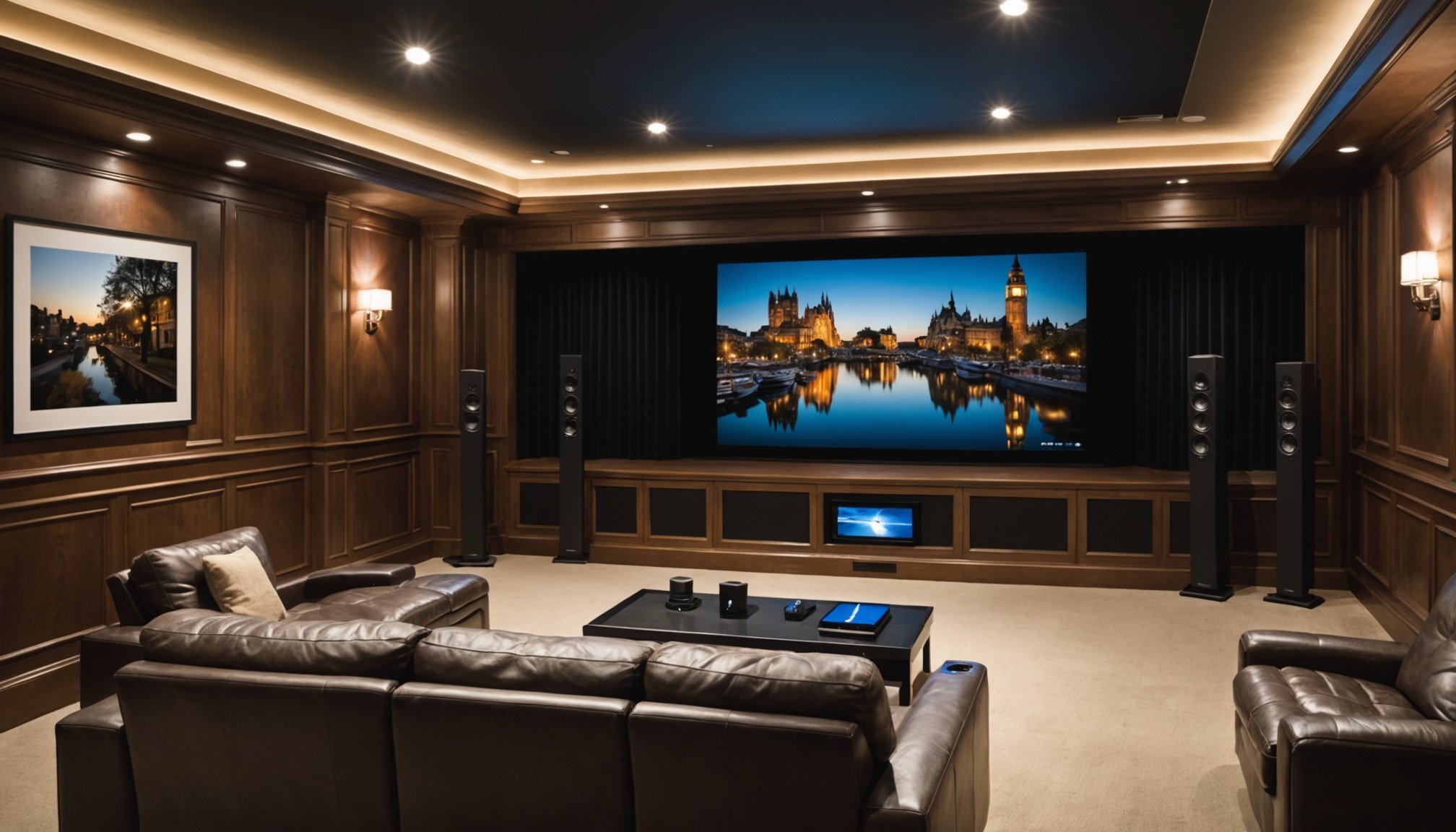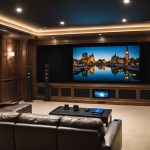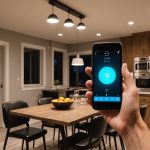Transforming your living space into a home theater can seem daunting, but your smartphone is the key to a seamless setup. Imagine enjoying your favorite films with stunning audio, all from the comfort of your couch. This guide walks you through each step, making the process simple and enjoyable. Whether you're a tech newbie or a seasoned audio enthusiast, you'll discover how to create an immersive surround sound experience without breaking the bank. Let's unlock the potential of your smartphone together.
Overview of Surround Sound Home Theater Systems
Surround sound technology transforms the home theater experience by delivering immersive audio that envelops the listener from all directions. This technology uses multiple audio channels and speakers strategically placed around a room to create a three-dimensional sound field. The result is a more lifelike and engaging experience that enhances movies, music, and games.
Also to discover : Mastering Your Smartphone: Effortless Control of Smart Home Air Purifiers for Fresher Indoor Air
There are various types of surround sound systems available, ranging from basic setups to advanced configurations. The most common formats include 5.1, 7.1, and even 9.1 systems, where the first number represents the number of main speakers, and the ".1" refers to the subwoofer for low-frequency effects. Each system offers different levels of immersive audio, catering to diverse preferences and room sizes.
In today's digital age, the importance of smartphone integration in home theater setups cannot be overstated. Smartphone integration allows users to control their surround sound systems effortlessly via apps, adjust settings, and stream content directly from their devices. This seamless connectivity enhances user experience by offering convenience and flexibility, making it an essential feature for modern home theaters.
Topic to read : Transform Your Home with a Smart Lighting System: A Step-by-Step Guide Using Your Smartphone
By understanding the benefits and options available, users can make informed decisions about which surround sound system best suits their needs, ensuring an optimal home theater experience.
Preparing Your Smartphone for Surround Sound Setup
To fully enjoy a surround sound system, it's crucial to optimise your smartphone's settings and apps. Several smartphone apps are designed to manage audio settings and configurations, enhancing your system's performance. Popular apps like Sonos, Bose Music, and Denon AVR Remote provide intuitive interfaces for controlling volume, balance, and other audio settings. These apps often come with features that allow for customising the sound to suit your preferences and room acoustics.
Adjusting your smartphone's audio settings is another important step. Ensure your device's sound output is set to the highest quality available. This might involve enabling high-resolution audio options or selecting the correct output format in your settings menu. By doing so, you can achieve clearer and more dynamic sound reproduction, ensuring an optimal listening experience.
Device compatibility plays a significant role in seamless integration. Check if your smartphone supports Bluetooth or Wi-Fi connections required by your surround sound system. Additionally, consider investing in accessories like wireless adapters or HDMI connectors if your current setup lacks native support. Ensuring compatibility between your smartphone and audio system will facilitate smoother operation and enhance your overall home theater experience.
Hardware Setup for Surround Sound
Setting up the home theater hardware for a surround sound system involves selecting the right components and configuring them correctly. To begin, choose a sound system configuration that suits your space, such as a 5.1 or 7.1 system. Essential components include a receiver, speakers, and a subwoofer. The receiver acts as the central hub, connecting all elements and distributing audio signals.
Connecting Speakers to Your Smartphone
To integrate your smartphone with the sound system, ensure compatibility with the receiver. Most modern receivers support Bluetooth or Wi-Fi, enabling seamless connection. Begin by pairing your smartphone with the receiver through your device's settings. Once connected, use a compatible app to manage audio settings, ensuring optimal sound output.
Best Practices for Speaker Placement
Proper speaker placement is crucial for achieving an immersive audio experience. Position front speakers at ear level, angled towards the listener. Place the center speaker above or below the TV, ensuring dialogue clarity. Surround speakers should be at ear level or slightly above, positioned to the sides or rear. The subwoofer can be placed anywhere in the room, but corners often enhance bass.
Consider room acoustics; soft furnishings and carpets can absorb sound, improving quality. Adjust speaker positions based on your room's layout to create the ideal sound field.
Optimizing Sound Quality
Enhancing the sound quality of your home theater system involves careful audio calibration and addressing common issues. Start by using an audio calibration tool or app, often included with your receiver, to measure and adjust sound levels according to your room's acoustics. This process ensures balanced audio output, crucial for an immersive experience.
Techniques for Calibrating Sound
Sound quality enhancement begins with proper calibration. Use your system's microphone or a smartphone app to test and adjust speaker levels. This helps in achieving uniform sound distribution. Ensure each speaker is correctly balanced, focusing on the dialogue clarity from the center speaker and the immersive effects from surround speakers.
Troubleshooting Common Audio Issues
Common audio issues, such as distortion or uneven sound, can often be resolved by checking connections and settings. Ensure all cables are secure and that your receiver settings match your speaker configuration. If problems persist, consult your system's manual for specific troubleshooting steps.
Additional Accessories for Enhanced Sound
Consider investing in additional accessories like acoustic panels or bass traps to improve sound quality. These can help manage echoes and bass response, offering a clearer and more dynamic listening experience. Enhancing sound quality not only elevates your entertainment but also maximises your system's potential.
Advanced Features and Customizations
In the realm of advanced audio features, smartphone apps are transforming how users interact with their surround sound systems. These apps offer a myriad of customization options that allow users to tailor audio settings to suit different types of media, such as movies, music, or games. For instance, some apps provide equalizer settings that let users adjust bass, treble, and mid-range frequencies for a personalised listening experience.
Exploring Advanced Features
Modern apps often include features like room correction and sound field optimisation, which analyse your room's acoustics and adjust audio output accordingly. This technology ensures that sound is distributed evenly, enhancing the immersive experience. Additionally, some apps offer voice control, allowing users to manage their audio settings hands-free.
Customizing Audio Settings
Customisation is key when it comes to different types of media. Users can create and save audio profiles for specific content, ensuring optimal sound quality whether watching an action-packed film or listening to a classical symphony. This flexibility enhances the overall home theater experience.
Emerging Technologies
Emerging technologies in surround sound and smartphone integration are paving the way for future innovations. Features like spatial audio and Dolby Atmos are becoming more prevalent, offering even more immersive and realistic soundscapes. As these technologies evolve, the integration between smartphones and home theater systems will continue to enhance user experiences.











